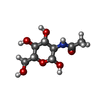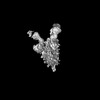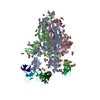+Search query
-Structure paper
| Title | Immunoglobulin germline gene polymorphisms influence the function of SARS-CoV-2 neutralizing antibodies. |
|---|---|
| Journal, issue, pages | Immunity, Vol. 56, Issue 1, Page 193-206.e7, Year 2023 |
| Publish date | Jan 10, 2023 |
 Authors Authors | Pradeepa Pushparaj / Andrea Nicoletto / Daniel J Sheward / Hrishikesh Das / Xaquin Castro Dopico / Laura Perez Vidakovics / Leo Hanke / Mark Chernyshev / Sanjana Narang / Sungyong Kim / Julian Fischbach / Simon Ekström / Gerald McInerney / B Martin Hällberg / Ben Murrell / Martin Corcoran / Gunilla B Karlsson Hedestam /  |
| PubMed Abstract | The human immunoglobulin heavy-chain (IGH) locus is exceptionally polymorphic, with high levels of allelic and structural variation. Thus, germline IGH genotypes are personal, which may influence ...The human immunoglobulin heavy-chain (IGH) locus is exceptionally polymorphic, with high levels of allelic and structural variation. Thus, germline IGH genotypes are personal, which may influence responses to infection and vaccination. For an improved understanding of inter-individual differences in antibody responses, we isolated SARS-CoV-2 spike-specific monoclonal antibodies from convalescent health care workers, focusing on the IGHV1-69 gene, which has the highest level of allelic variation of all IGHV genes. The IGHV1-6920-using CAB-I47 antibody and two similar antibodies isolated from an independent donor were critically dependent on allele usage. Neutralization was retained when reverting the V region to the germline IGHV1-6920 allele but lost when reverting to other IGHV1-69 alleles. Structural data confirmed that two germline-encoded polymorphisms, R50 and F55, in the IGHV1-69 gene were required for high-affinity receptor-binding domain interaction. These results demonstrate that polymorphisms in IGH genes can influence the function of SARS-CoV-2 neutralizing antibodies. |
 External links External links |  Immunity / Immunity /  PubMed:36574772 / PubMed:36574772 /  PubMed Central PubMed Central |
| Methods | EM (single particle) |
| Resolution | 2.4 - 2.7 Å |
| Structure data | EMDB-15269: SARS CoV2 Spike in the 2-up state in complex with Fab47 EMDB-15270, PDB-8a95: EMDB-15271, PDB-8a96: EMDB-15273, PDB-8a99: |
| Chemicals |  ChemComp-NAG: |
| Source |
|
 Keywords Keywords | VIRAL PROTEIN / Spike / Antibody / SARS-CoV2 |
 Movie
Movie Controller
Controller Structure viewers
Structure viewers About Yorodumi Papers
About Yorodumi Papers











 homo sapiens (human)
homo sapiens (human) severe acute respiratory syndrome coronavirus
severe acute respiratory syndrome coronavirus